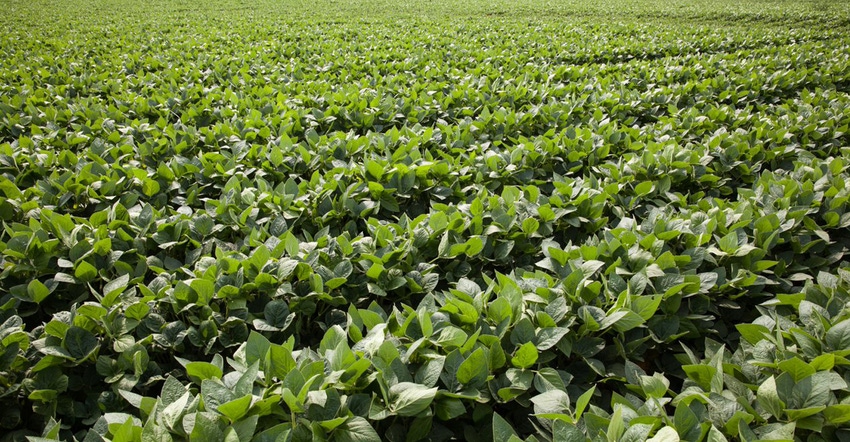June 4, 2019

Delayed planting, along with continued cool and wet conditions, has taken a toll on crops this spring. With the plants’ delayed emergence, and wet, cool weather patterns expected to continue, growth and development of a crop will continue to lag.
Also, expect corn and soybean plants to reach grain fill stage later than usual this season, creating a window of opportunity for plant diseases to impact yield. The earlier a plant disease occurs during grain fill, the more likely it will negatively impact yield, says Alison Robertson, Iowa State University Extension plant pathologist.
In this article, Robertson and ISU Extension plant pathologist Daren Mueller discuss the potential for higher incidence of certain diseases this growing season, and how to manage their impact as best possible.
Understanding disease triangle
When evaluating plant disease risk, it’s best to refer to what plant pathologists call the “disease triangle.” The triangle is a visual representation of the three things that must happen for disease to occur.
Darcy Telenko, field crop pathologist at Purdue University, provides an informational graphic that helps illustrate how manipulating the three points — pathogen, host and environment — affects disease presence and pressure. Being able to manipulate all three variables can help reduce severity and disease impact:
Environment. Many corn and soybean diseases thrive in cool, wet environments. When identifying the possibility of disease occurring, it’s best to evaluate future weather forecasts, as well as keep track of the growth stages of crops during the particular time period, as conditions may favor disease development.
According to USDA’s Midwest Ag-Focus Climate Outlook in May, wet conditions will continue as summer progresses, making development and disease a “likely problem for corn.” Such conditions will leave corn development (or grain fill) in need of growing degree days this season, and forecasts offer no relief on the horizon for the Midwest.
Pathogen. Given the potential to have a suitable growing environment for various pathogens, it’s best to determine if your field has pathogen inoculum that will be able to thrive in this environment.
Plant pathogens overwinter on diseased plant tissue. While it’s always important to perform quality checks and regular crop scouting in your fields, years like 2019 highlight just how beneficial keeping accurate records of annual field conditions can be.
With a knowledge of what you saw in fields in prior years, you can be more equipped to handle potential diseases in future years. Regular scouting this year will help you discover diseases early and give you the best chance at managing them. It also allows you to assess future risk for next year.
According to preliminary testing results from the University of Wisconsin-Madison, on average, tar spot has a 20% spore survival rate throughout winter. This means inoculum will be present in fields in eastern Iowa, which had confirmed cases of tar spot in 2018. Also, the forecast of cool, wet conditions may favor disease development. Consequently, these fields and adjacent fields should be scouted regularly for tar spot so management practices, such as fungicide applications, can be implemented quickly if necessary.
Host. The final piece of the triangle is the host. Think about genetics and growth stage of the host when infection occurs. A pathogen may infect a host with resistance, but the disease either fails to develop or develops very slowly. A pathogen may also infect a host at a growth stage that is not detrimental to yield.
In soybeans, one such disease to be mindful of this growing season is white mold, which limits yield the most when it starts during flowering. Given the cool, wet conditions slowing down soybean growth, it’s important to scout for this disease, especially because the senescing flowers may coincide more with the release of ascospores (spores of the white mold-causing pathogen released by apothecia).
The Sporecaster app, developed by University of Wisconsin, is a tool to consult for risk of white mold development and to determine if spraying a foliar fungicide might be necessary. Should warmer, drier and sunnier weather return in the summer, it’s possible the period of senescing flowers and ascospore release will not coincide, or the flowering periods will be reduced before podding.
Growing a resistant hybrid or cultivar, could greatly reduce how much disease occurs in your crops. Be sure to consult your seed dealer for more information about your varieties.
Keep updated on disease development
Even if your fields didn’t have tar spot, white mold or other diseases in 2018, paying attention to what diseases are occurring in other states will be important in 2019.
Remember, pathogens can travel, predominantly via wind or storms. If a disease is prevalent in a neighboring state, the amount of inoculum there will be high and could be a threat to Iowa depending on prevailing winds, and if the other two points of the triangle — host and environment — favor disease development.
Crop scouting in 2019 will be more important than ever. If you need to brush up on your disease ID knowledge or fungicide efficacy, resources are available, including the Crop Protection Network and Iowa State University Extension.
Source: ISU, which is responsible for information provided and is wholly owned by the source. Informa Business Media and its subsidiaries aren’t responsible for any of the content contained in this information asset.
You May Also Like




